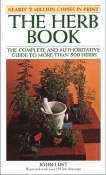VIBRANT HEALTH ON A TIGHTWAD
BUDGET (part two)
by Carol Tashel
part
one
HEALTH IN A PILL?
In cultures where longevity was common and degenerative
disease rare, the traditional diet functioned like preventive
medicine. It featured hearty broths, a dizzying variety
of vegetables and wild herbs, small amounts of nutrient-dense
meats (including liver, kidney, etc.), fermented grains
and cultured dairy products with beneficial bacteria, loads
of fiber, minerals, natural anti-oxidants and anti-inflammatory
compounds. (These diets didn't contain chemicals, hydrogenated
fats, sugars, refined or fake foods, etc.) Many "modern"
people pop acidophilus capsules, take dessicated glandulars,
mineral supplements and Omega-3 fish oil, hoping for the
best.
 If only we could take a few pills and guarantee vital health,
right? Well, it's not that simple. In general, vitamins,
minerals and trace elements depend upon each other. Good
quality food and herbs, in a diverse, well-prepared diet,
contain these elements, in just the right balance. What
if we returned to eating not one or two, but all of these
complete foods? Could we set the supplements aside? (I understand
that people with serious health challenges may need supplements
to help turn things around.)
If only we could take a few pills and guarantee vital health,
right? Well, it's not that simple. In general, vitamins,
minerals and trace elements depend upon each other. Good
quality food and herbs, in a diverse, well-prepared diet,
contain these elements, in just the right balance. What
if we returned to eating not one or two, but all of these
complete foods? Could we set the supplements aside? (I understand
that people with serious health challenges may need supplements
to help turn things around.)
I know what you're thinking: "But how could we get
what we need? Our world is so toxic, soils are depleted,
and foods don't contain the nutrients they once did."
Good point. My answer? Look for a complete palette of essential
elements in the neglected weeds of the land and sea--wild
foods and seaweed.
It pays to acquire a taste for sea vegetables, which offer
a bounty of minerals and trace elements. Eating just two
tablespoons a day is a reasonable and affordable goal. I
regularly use seven different tasty varieties, most of them
gathered in clean waters off the coast of Mendocino.
Wild greens and herbs contain a gold mine of vitamins and
minerals (always gather them on clean land). For example,
wild dandelion leaves boast about twice the beta carotene
and calcium as spinach. Lambsquarters, purslane, dandelion,
amaranth greens and mallow are delicious and free for the
taking, probably in your backyard!
There are a couple of inexpensive supplements that can
really make a difference. One is cod liver oil, an "old-fashioned"
item with an A+ reputation. It nourishes the cardiovascular,
nervous, immune and respiratory systems, bones, skin and
more. If you just can't chug the oil, then try capsules.
To avoid a potentially dangerous buildup of vitamin D, take
the oil only from mid-October to mid-April, and don't use
it when living in a tropical area.
The other is flax seed. It's a food, an herb and a medicine,
and a month's supply costs only a few bucks. Freshly ground,
raw flax seeds help prevent breast and prostate cancer,
normalize the menstrual cycle, and are anti-inflammatory.
GOOD FOOD = GREAT HEALTH INSURANCE!
 Many
people seek the omega-3 cold-water fish oils, and end up
purchasing relatively affordable farm-raised salmon (which,
by the way, has considerably lower levels of omega-3s than
its wild brethren). Since health problems abound on most
fish farms, you'll want to avoid farm-raised; but then the
real thing--wild salmon--may be out of range for your tightwad
budget.
Many
people seek the omega-3 cold-water fish oils, and end up
purchasing relatively affordable farm-raised salmon (which,
by the way, has considerably lower levels of omega-3s than
its wild brethren). Since health problems abound on most
fish farms, you'll want to avoid farm-raised; but then the
real thing--wild salmon--may be out of range for your tightwad
budget.
Consider sardines! Some people have unpleasant visceral
reactions to this suggestion, but there are some very good
tasting brands, like Bela. Sardines are cheap, eminently
therapeutic, and these baby fish haven't had time to accumulate
mercury. Eat whole (not boneless/skinless), smoked sardines,
packed in olive oil (not cottonseed or soy oil). Cost? As
little as $1.60 per can--even lower if you purchase by the
case.
Many of the best meals start with sautéed onion
and garlic (rich in anti-oxidants). A once-weekly serving
of shiitake mushrooms (tasty immune support) might cost
$1.50. Miso, a traditionally fermented food, is easy to
add to your diet. Thin a scant teaspoonful in a bit of water
and add to soups or stews just before serving (cooking kills
the organisms), or mix with tahini for a sandwich spread.
My favorite is the "mellow white" variety. A reasonable
amount of complex carbohydrates--dried beans, whole grains,
etc.--are important, too. If pre-soaked or sprouted, so
much the better.
Nuts and seeds have such excellent credentials that they
deserve a place on your table. Pumpkin, sunflower and sesame
seeds; New Mexico-grown pecans; lightly roasted almonds
and walnuts...buy them raw, in bulk, for the best prices.
Excess carbohydrate intake is the usual culprit when it
comes to weight gain, but if you tend that way, you may
need to limit your nuts.
Top quality saturated and monounsaturated fats play a critical
role in body chemistry: These include grass-fed meats, olive
oil, coconut oil, real butter and ghee, avocado, goat and
sheep cheese, buttermilk, unsweetened yogurt. Actually,
dairy products made from raw milk are far superior to pasteurized,
but they're hard to find (some are illegal to sell). In
New Mexico, certain raw milk cheeses are available (Organic
Valley brand is one)--check your specialty cheese counter
or local farmers for raw options, and look for the best
buy. (Some may not thrive on meat or dairy, so fine-tune
these issues with a practitioner.)
Include generous amounts of fruits and vegetables, whose
brightly colored pigments store resveratrol, carotenoids,
lycopenes, anthocyanins, epicatechins and all those unpronounceable
things that are so good for you. They also balance out excess
acidity in the body. In general, the darkest, richest colors
offer the most (cabbage and cauliflower being notable exceptions).
Don't eat only broccoli; make friends with collards, kale,
Swiss chard and bok choy. In the fruit world, blueberries
rank number one in antioxidants, followed by raspberries,
sour cherries, blackberries and strawberries. These powerful
fruits can be kept frozen and used daily. In small quantities,
unsulfured dried fruits like apricots, figs and raisins
have many benefits. Combine fruits with nuts and yogurt
for a balanced snack. Fruit juice is pricey and contains
loads of sugar. Instead, eat whole fruit or dilute your
juices.
ANCIENT, ELEGANT MEDICINES
While the pharmaceutical industry appears to be in the midst
of a long-overdue moral crisis (over Premarin, Prozac, Vioxx,
Celebrex), and public confidence in drugs is heading toward
the gutter, the world of herbal medicine marches on as it
has for thousands of years, safely providing unique qualities
unavailable in drugs. And they don't cost much. The ultimate
way to save money on medicines is by growing or gathering
plants for a home pharmacy. You can address an astonishing
number of minor health conditions with a few ordinary herbs
like chamomile, mullein, peppermint, yarrow, etc.
Robust health is more likely when you encourage harmonious
gut functioning, keep your liver happy and soothe your adrenal
glands. Herbs easily accomplish such goals. Tea blends with
plants like nettle, red clover, oatstraw, raspberry leaves,
horsetail and spearmint, offer minerals in abundance. Frequent
use of culinary herbs do more than simply flavor your food.
They're medicines, too, and as their volatile compounds
pass through your body, they relax your gut, prevent infection,
and more. Use minimal amounts of ginger, cayenne and cinnamon
(rather heating); add basil, thyme, oregano, fennel, dill
and rosemary with a heavier hand.
Here's one example of a combination tonic that covers a
lot of bases, acting on the liver, kidneys, skin, circulation,
gut and adrenal glands. Mix dried herbs in a jar: Two parts
each Jamaican sarsaparilla root and Eleuthero root (formerly
Siberian ginseng); one part each burdock root and dandelion
root; one-half part each licorice root and ginger root.
Simmer one level teaspoon of the root mixture in a cup of
water for ten minutes, and drink one to two cups a day.
Herbalists can suggest a daily tonic blend to support your
well-being, based upon your individual constitution.
It's my fervent wish that people could be healthy without
spending a fortune. Self-care is a revolutionary act in
a culture steeped in consumerism, and where health care
is big business. So find practitioners who will teach you
skills to care for yourself and try a few of my suggestions.
I wish you vibrant health!
RESOURCES:
* GARDENING the SOUTHWEST: How to care for your land while
growing food, beauty and medicine, by Carole Tashel (1999,
Healing Earth Publications) - Available from the author

CAROLE TASHEL, CLINICAL HERBALIST *
www.caroletashel.com
Bio: Carole Tashel, an avid student of the school of nature
for over 25 years, is still moved by the beauty, effectiveness
and revolutionary aspects of natural healing. She works
with wild and cultivated plants as a clinical herbalist,
teacher and gardener, and is co-founder of the “Pay
What You Can” Wellness Clinic. Carole trained with
Michael Moore at the Institute of Traditional Medicine and
was a consultant for eight years in Santa Fe’s outstanding
retail store, Herbs, Etc. She wrote Gardening the Southwest:
How to care for your land while growing food, beauty and
medicine (1999).






